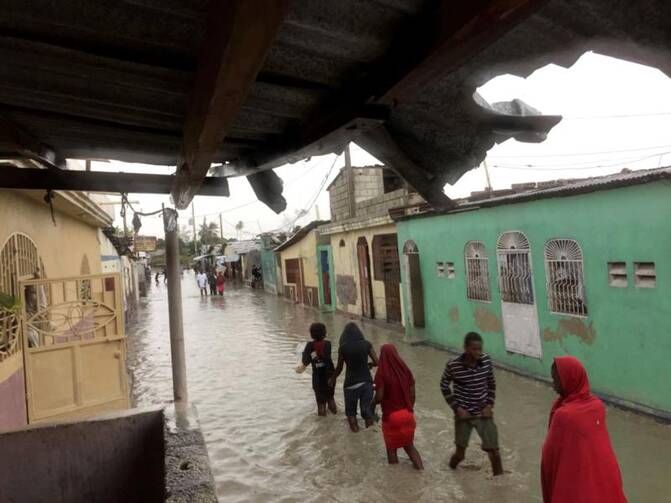Wind-whipped rains from Hurricane Matthew shattered Haiti's southwest peninsula, downing trees, ripping open makeshift wooden homes and causing widespread flooding on Oct. 4 as aid workers waited for the storm to subside before mobilizing.
The city of Les Cayes and coastal towns and villages in South Department were experiencing the most destruction as the storm made landfall at dawn with 145-mile-an-hour winds.
Forecasters expected Matthew to dump up to 30 inches of rain in most communities, with some locales receiving up to 40 inches.
Les Cayes and surrounding areas were the focus of concern for Catholic Relief Services. Kim Pozniak, communications manager, told Catholic News Service that the potential for landslides was high because of the geography of the region.
She said CRS staff also was troubled over the well-being of residents who decided to stay in their homes despite calls to evacuate.
"I was told by staff in Les Cayes yesterday (Oct. 3) that the government was going around with megaphones to alert people. But many decided to stay put to protect their homes and belongings. We've heard that some people did not think the storm would be as severe as predicted," Pozniak said.
She said Chris Bessey, CRS country director, had been in contact with CRS staff in Les Cayes, despite disruptions in electrical and internet service.
"Trees were knocked down and also there was some flooding already," she said. "We're unable to communicate with the staff in Les Cayes because everything is down."
The agency had positioned relief supplies, including food, sanitation and kitchen kits and emergency shelter materials in warehouses in the area, and workers were prepared to begin delivering aid once the storm moved north. Engineers were stationed in three locales and were preparing to begin assessing damage to homes and to help people with the shelter materials, Pozniak said.
In the hours before the storm made landfall, CRS staff had assisted Haiti's Civil Protection Agency by offering vehicles and fuel for use to help with evacuation, she added.
CRS and at least one other Catholic agency had begun accepting donations for their emergency responses in Haiti:
- Catholic Relief Services online at donate.crs.org/hurricane-matthew-crs; via mail to P.O. Box 17090, Baltimore, Maryland, 21297-0303 and indicate Hurricane Matthew in the memo; or call toll-free 877-435-7277 from 8 a.m. to 11 p.m. Eastern time.
- Catholic Medical Mission Board online at www.cmmb.org/donations/hurricane-matthew/.
Heavy rains also pounded the capital of Port-au-Prince, causing some flooding in low-lying areas, but winds were not as severe, Jacques Liautaud, Haiti manager for the church rebuilding project known as PROCHE, told Catholic News Service on Oct. 4.
"We're seeing mostly rain and a few gusts of high winds. Otherwise, it's been relatively calm," said Liautaud, who was in the country monitoring construction projects underway to help the Catholic Church rebuild after the country's powerful 2010 earthquake.
"The city is pretty shut down today. Everybody is sheltering in place," he said.
Liautaud added that Haitian media reported that at least three people had died because of the storm. The reports could not be immediately confirmed.
The center of Matthew was expected to continue on a northward path through the Windward Passage between Haiti and Cuba. Heavy rains were expected in eastern Cuba, and hurricane warnings were issued for the Bahamas and Turks and Caicos Islands. Weather forecasters in the United States were keeping an eye on the storm's path and expected it to pass just offshore from Florida and the southeast coast. Florida Gov. Rick Scott declared a state of emergency for the entire state Oct. 3.
Hurricane Sandy in 2012 was the most recent violent storm to strike Haiti, causing widespread flooding in many of the same communities affected by Matthew. Sandy also devastated Jamaica and eastern Cuba. In all, more than 70 people died in the Caribbean from the late-season hurricane. Sandy made its way northward, taking aim on New Jersey and New York to become the second costliest such storm in U.S. history.








